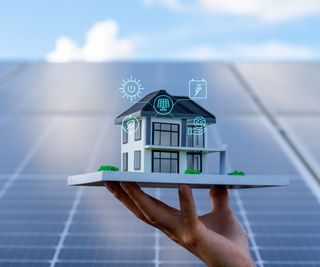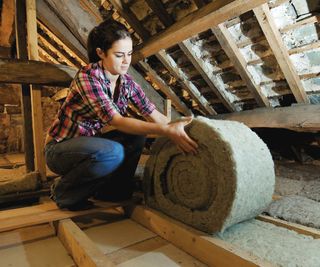How to work out your energy needs and choose the right renewables
Knowing how to work out your energy needs and choose the right renewables for your home can be a process you start yourself — if you know how. Here's what we discovered

If you're wondering how to work out your energy needs and choose the right renewables, it's likely you're on a quest to create a more energy-efficient home. Whether this means you're looking at how to choose heat pumps or considering the switch to solar, choosing the best solution will come down to a number of different variables.
Whether your driving factor is cost, or you're looking to contribute towards a Net Zero climate, there will be a number of factors which impact your energy needs, usage and what is currently available to you as a replacement.
We asked the experts how to start the process and reveal when you might need to call in the professionals.
How to work out your energy needs and choose your renewables
"The key to working out your energy needs is first to understand your usage," says Tamara Birch, senior writer at The Eco Experts. "If you know how much energy you use every day, week and month, you’re in a better position to know what your needs are."
If you are already living in your home, then the good news is finding out your energy use is pretty simple. "If you are mains connected, you just need to read your bills," says Steve Cole, retrofit co-ordinator at the Centre for Sustainable Energy. Your projected annual usage is shown on your monthly bill and you can of course refer to previous bills to see what you actually used.
On the other hand, if you are building a house from scratch, this will be calculated at the design and planning stage and is referred to as your Standard Assessment Procedure or SAP calculations.
That said, Steve Cole shares a word of warning about SAPs. "SAPs often overestimate a building's efficiency," says Steve. "For new builds, working with architects and energy consultants who specialise in low-energy design would be advisable if this is the route you are planning on taking."

Tamara Birch, Senior Writer for The Eco Experts, has written about environmental topics for over four years. This includes advising on cost-effective ways, like solar panels and energy-efficient products, to help businesses and homes become more sustainable.

Steve has worked across various domestic retrofit projects and has over 18 years’ experience working in construction both in the UK and overseas. From labourer to site and project management, Steve has a vast wealth of expertise in sustainable energy.
Assess your current home
When working out your energy needs on an existing property, it's a good idea to start with an investigation into how your home deals with heat loss. After all, the less efficient it is, the more heat you will need and subsequently use.
It's also a necessary process if you have specific questions, such as are heat pumps suitable for old homes?
Steve Cole recommends looking at the following areas:
- Building characteristics – How is your home constructed, what materials is it made of and have any adaptations taken place?
- What type of home is it – detached, semi-detached, terraced or rural?
- Your current energy usage patterns – daily and seasonal changes
- Home insulation levels – how much do you have and is it working well?
- Home ventilation - do you rely on natural methods of ventilation or do you have an MVHR system?
- Moisture management – do you have damp or mould in your house?
- Heritage impact – do you live in a conservation area or will you need listed building consent for any alterations or updates to your heating?
Working out the answers to these questions will all start to form a clearer picture of why your home uses the energy it does, if it is suitable for an alternative system and if so, potentially which type of renewable is best.

Determine your energy use
When assessing your family's energy needs, you will need to start by considering your lifestyle and how your energy usage is split, says David Hilton, Homebuilding & Renovating's energy expert.
"Look at your electricity use versus how much gas, oil or LPG you use. Think about how much hot water you need compared to how much you use your heating," says David. "When do you need energy the most? Are you at home all day or mainly during evenings and weekends? Does your seasonal use vastly change?
"It's a little like making a new car purchase," he explains. "You'll look at how many miles you do per year and then look at how a car performs on a miles per gallon basis. Assessing your energy needs and assessing which type will give you the best cost and performance is much the same."
There are also less tangible questions worth considering, such as the type of heating you prefer. Do you look for a home that feels at a constantly comfortable temperature, or do you prefer to be able to touch a direct source of heat?
While underfloor heating – a good option with low temperature heat pumps for example – may not always feel warm to touch, it will keep your home at an ambient temperature. Radiators on the other hand tend to operate for set periods of time and will feel warmer the closer you are to them. What does warmth mean to you and how do you want to heat your home?
Furthermore, if you're renovating rather than building a new home, you need to consider whether you have the budget to update the existing emitters as well as the heat source. Removing floors to add underfloor heating, for instance, will invariably add cost to your project.
Make fabric first improvements
Although you could simply look at your energy usage and annual costs and assume these will reduce when you switch to a more sustainable energy source, this is not always the case if your home isn't as protected as it could be.
"Consider the potential need for energy efficiency improvements in your home first," says Steve Cole. "An energy leaky home is wasteful whether the energy is renewable or not!"
So, if during the assessment of your home you have discovered issues with insulation, draught-proofing and/or damp, do consider putting measures in place to improve them. It will all help to reduce your energy usage.
If your home is cosier because of your fabric first improvements, you'll need less energy to keep it that way which will benefit both you and the environment in the long run.

Decide your reason for change
Understanding why you're investigating how to work out your energy needs and choose the right renewables is also an important part of the process say the experts. In general, swapping to a renewable heat source comes down to two reasons — cost, more specifically, long-term running costs, and sustainability. But which one matters most to you?
“Cost is a huge factor in influencing the decision to move to a different type of energy, as it can be significantly cheaper to invest in renewable energy than other types," acknowledges Tamara Birch.
"This can be really beneficial if homeowners are considering solar panels", for example, she says, "as they can utilise The Smart Export Guarantee that allows large energy suppliers to pay homeowners for renewable energy they send back to the National Grid."
Other costs savings to offset initial costs can also be made by using the Boiler Upgrade Scheme to install a heat pump.
While running costs for most alternative energy methods will often be lower, particularly when combined with improving the thermal efficiency of your home, "of course, many consumers are also trying to rapidly reduce their environmental impact," says Tamara, "and this may influence their energy choices too.”
However, as all new systems involve an initial outlay and investment, it's important to decide what is your overriding reason for change and what will bring the most tangible benefits.
Understand logistics
While annual running costs and any subsequent savings will play a part in your choice of renewables, it's also vital to make sure you understand the physical or logistical requirements of each different type of system.
To begin, there are site-specific requirements which are fairly well documented when it comes to some of the more mainstream renewable technologies. For instance, the need for an adequate amount of roof space and roof orientation for installing solar panels is fairly obvious. Again, most people understand that air source heat pumps are placed outside and we know that ground source heat pumps need a garden or outdoor space for pipework to be installed.
Again, the physical requirements of wind turbines and micro hydro power – such as the presence of a water course of the right head and flow rate – may mean they're not an option for many households.
However, there are other requirements for some options which may be less obvious. The location of your home being one if you are considering biomass boilers, for example — and I speak from personal experience in raising this point.
Firstly, find out how close your nearest supplier is and what their delivery charges are. Paying excess delivery charges because your pellets come from far away will eat into your cost savings.
Secondly, if you have a larger home and will need a bigger automatic hopper to store and feed pellets into the boiler, you will likely want those to be blown into the hopper rather than adding them by hand. Five tonnes of pellets in bags takes up a lot of room and involves a lot of effort to put them in place. I had the blisters to prove it at one point.
As you will generally find that larger deliveries arrive on big lorries containing many other tonnes of pellets (not just yours), if you live in a rural location with narrow access lanes, you'll need to research the size of the lorry your supplier uses to check it will fit.

Do I need to employ an expert?
If you're comfortable you've established the basics regarding your energy use and your needs, it's still advisable to call in an expert before you make any changes. There are a number of options available to you, depending on where you are seeking most help.
If you're looking at your Energy Performance Certificate (EPC) rating and think it may be too low for a lower temperature heat pump to work, try considering a heat loss survey instead says Steve Cole. A heat loss expert will assess your home for its thermal efficiency, as even if your EPC rating is low, you may find it loses less heat than you expect.
Alternatively, if you are set on using heat pumps, "consult a trained and competent heating engineer," says Steve Cole, "as it's important to recognise that proper sizing of a heat pump is crucial for efficiency and cost-effectiveness."
Likewise, if you are considering solar power, using a solar expert to advise on the suitability of your home's location, position and available roof space will be essential.
While you can start by putting your postcode into Solar Wizard to get initial feedback on whether it's an option, there will still be plenty of other considerations to weigh up such as your solar panel roof suitability. Contact a number of recommended suppliers and book initial surveys to gain as much information as you can.
Or, if you feel looking at your energy use, needs and options, are all best done by a professional, booking an independent home energy audit may be a good starting point, or take a look at the Government-led Green Deal scheme whereby an assessment and recommendations can provide you with a plan.
Keen to learn more but still not sure exactly what renewables might suit you best? Find out what is biomass and if you could reap extra rewards from using solar panels and heat pumps together.
Get the Homebuilding & Renovating Newsletter
Bring your dream home to life with expert advice, how to guides and design inspiration. Sign up for our newsletter and get two free tickets to a Homebuilding & Renovating Show near you.

Sarah is Homebuilding & Renovating’s Assistant Editor and joined the team in 2024. An established homes and interiors writer, Sarah has renovated and extended a number of properties, including a listing building and renovation project that featured on Grand Designs. Although she said she would never buy a listed property again, she has recently purchased a Grade II listed apartment. As it had already been professionally renovated, she has instead set her sights on tackling some changes to improve the building’s energy efficiency, as well as adding some personal touches to the interior.